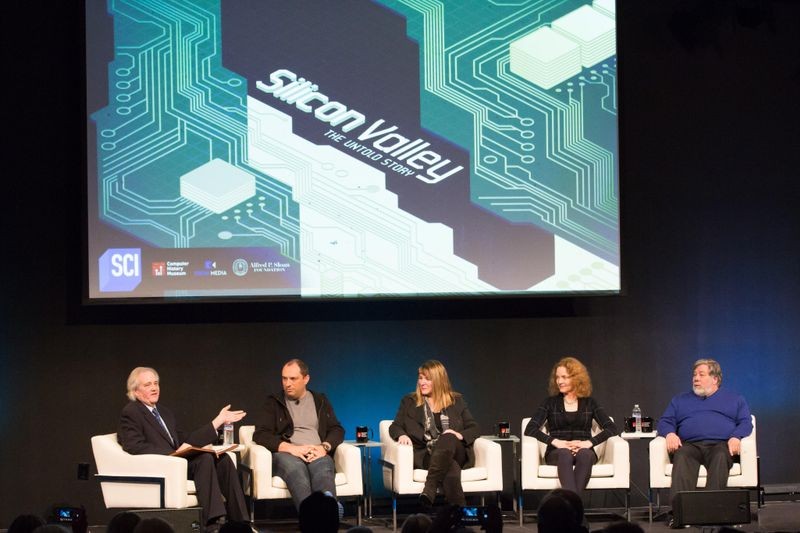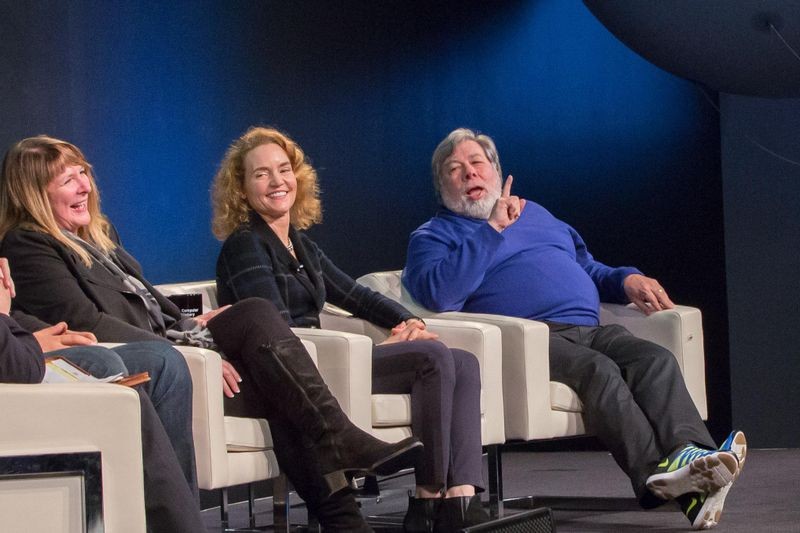

Moderator Michael Malone in conversation with film participants Jan Koum, Heidi Roizen, Kim Polese, and Steve Wozniak during “Silicon Valley: The Untold Story,” January 17, 2018. Produced by the Exponential Center at the Computer History Museum.
Silicon Valley: The Untold Story, a new three-part documentary from award-winning Kikim Media airing on Discovery’s Science Channel in March 2018, reveals what has made Silicon Valley a hotbed of innovation and entrepreneurship for decades. As the community and educational outreach partner for the film, the Computer History Museum (CHM) hosted a premiere event with a panel discussion of Valley leaders featured in the movie: WhatsApp cofounder Jan Koum, technology entrepreneur Kim Polese, DFJ venture capitalist Heidi Roizen, and Apple cofounder Steve Wozniak. Journalist Michael S. Malone moderated the session, which was followed by a sneak preview of the first segment in the film series, “Secret Sauce.”
These successful entrepreneurs are living the American Dream. Born into modest families, they worked hard to build rewarding and lucrative careers. Though the details of their stories vary, elements of the “secret sauce” of Silicon Valley are a common thread. These elements include industries that attracted talented engineers and innovators from all over the world, top universities, mentor entrepreneurs, access to capital, and a culture that encourages risk-taking and learning from failure.

Jan Koum describes his first impression of the United States.
Jan Koum, cofounder and CEO of WhatsApp, emigrated from Ukraine in 1992 and settled with his mother in Mountain View, California, where they had relatives. Driving from the San Francisco airport, his first memorable image of America was the way everything was lit up with bright lights. The other panelists are natives and remember Silicon Valley’s transition from fruit orchards to semiconductor manufacturing. Heidi Roizen, operating partner at Draper Fisher Jurvetson, was born at Stanford Hospital to immigrant parents. She watched the Valley evolve into an epicenter of technology, driven by the engineers like her father who came to work in defense and other industries. Kim Polese, a self-proclaimed “girl geek” and chairman of CrowdSmart, grew up in Berkeley and went to work in the Valley directly after graduating from the University of California at Berkeley. Her parents were also immigrants and like Steve Jobs, Polese remembers playing in the basement with lasers that her father brought home from his work at Spectra Physics. Apple cofounder Steve Wozniak grew up near Lockheed, where his engineer father worked and brought home discarded electronics for his son’s hobby: building computers.

Steve Wozniak recalls the Silicon Valley of his childhood.
Each of the panelists identified the time when they believed Silicon Valley became the capital of the tech world. Koum and Roizen agreed that it happened when Netscape Navigator made the web accessible and the internet arrived. With the ensuing dot.com boom, Silicon Valley became known to everyone. Polese identifies the time when the personal computer became ubiquitous in the 1980s. She remembers that when she bought her first personal computer in college, an Apple II, it made her feel powerful because she could “do stuff on it.” Steve Wozniak believes it all goes back to the silicon chips and the companies that made them, and he selected the early 1970s as the time when the area first began to be called Silicon Valley. He notes that the term is now applied to the entire San Francisco Bay area. But, why did these world-changing innovations all come from the same place?
In a clip from the film series, Jan Koum explains that entrepreneurship and innovation happen in Silicon Valley because of a never-ending circle: the best engineers are attracted to the best companies, the companies are funded by venture capitalists, who are here because the best companies are here, and the best companies are here because the best engineers are here, etc.
Koum should know. From a child who used an abacus at school and then struggled through difficult financial times in his teens, he eventually landed a job at Yahoo. Cashing out his stock options in 2007, he developed WhatsApp with fellow Yahoo engineer Brian Acton. But the excitement Koum felt creating the app didn’t translate to users. With some iteration and venture funding, however, WhatsApp’s became the largest acquisition in Silicon Valley history at that time. Koum believes it couldn’t have happened anywhere else.
Jan Koum describes WhatsApp’s acquisition by Facebook.
Today, WhatsApp has over 1 billion active daily users and 1.3 billion monthly active users. Rather than retire after the company was acquired by Facebook for an astonishing $19 billion in 2014, Koum still goes to work every day. Why? He says there’s still more to do to serve his users.
All of the panelists agreed that none of them set out to build a company for acquisition. Instead, they were motivated by a passion to build something great that people would want to use. The business and financial success was secondary. An engineer at heart, Wozniak’s aversion to corporate business and work hierarchies is legendary. What may be lesser-known is that he put his money where his mouth was, giving away or selling Apple stock at pre-IPO prices to more than 80 deserving employees.
Steve Wozniak recognizes key employees.
Success stories should not mask the darker side of Silicon Valley, however. The film addresses sexual discrimination and harassment faced by women in its male-dominated culture. Heidi Roizen discussed being “the only woman in the room” when she was the CEO of early software company T/Maker, and Java developer Kim Polese shared her frustration at the “fluff” pieces written about her when she was CEO of Marimba. Both women are committed to serving as role models for girls and young women entrepreneurs. They believe that the dismal numbers of women graduating with computer science degrees despite years of STEM initiatives aimed to equalize the pipeline is finally changing. At a recent trip to a startup, Roizen was pleased to hear that their five newest hires were all women.
Heidi Roizen and Kim Polese on the challenges of being a woman CEO.
Though there is still much to be done, Roizen and Polese believe that conditions are different for today’s women in tech, a reminder that things are always changing—even in their lifetimes.
In another reminder of change in the Valley, Steve Wozniak pointed out that when Apple was founded, the amount of memory that could hold one song cost a million dollars. Today, Apple is on track to become the first trillion-dollar company. But Woz was confident from day one that Apple would be successful. Games brought computers into the home and there was no looking back. He’s still on the payroll of the company he founded, proud of what it has accomplished. And he himself continues to explore new ideas, because, he says, “it’s fun to be around a few friends who have a neat new idea.”
Like Silicon Valley itself, these entrepreneurs continue to reinvent themselves, keeping their minds open, meeting new entrepreneurs, and exploring new challenges and problems to solve. They embody perhaps another element of the secret sauce of Silicon Valley and perhaps the most enduring—an insatiable curiosity.
Learn more about the film and watch the trailer here. The series is supported by the Alfred P. Sloan Foundation. The Computer History Museum is the community and educational outreach partner for the project.
“Silicon Valley: The Untold Story,” January 17, 2018. Produced by the Exponential Center at the Computer History Museum.
The Exponential Center at the Computer History Museum captures the legacy —and advances the future—of entrepreneurship and innovation in Silicon Valley and around the world. The center explores the people, companies, and communities that are transforming the human experience through technology innovation, economic value creation, and social impact. Our mission: to inform, influence, and inspire the next generation of innovators, entrepreneurs, and leaders changing the world.